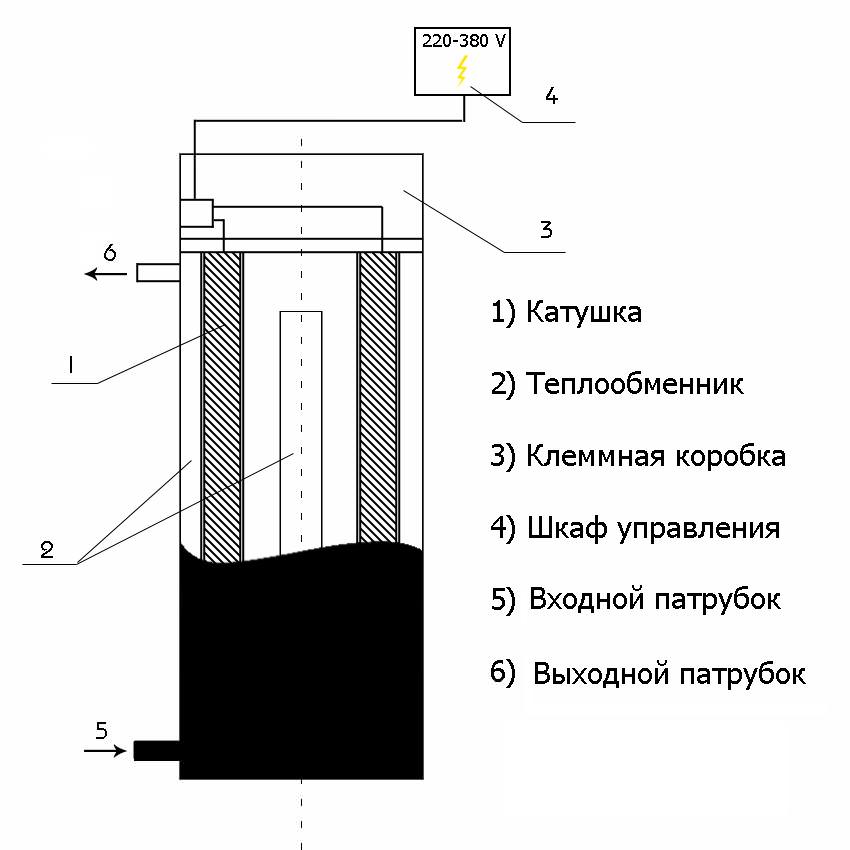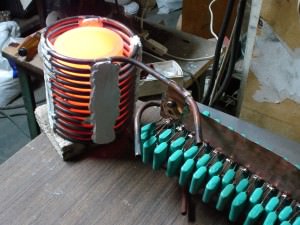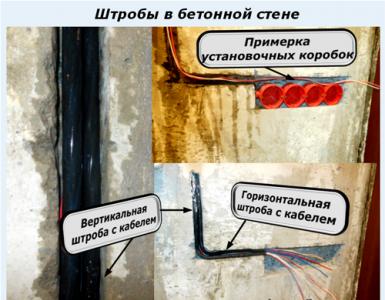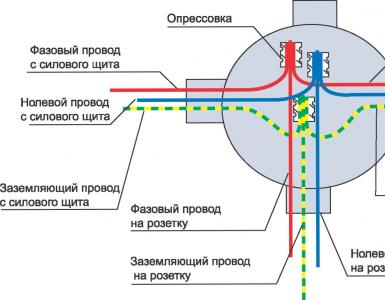How to make an induction heater with your own hands?
Induction heaters work on the principle of “getting current from magnetism”. In a special coil, a high-power alternating magnetic field is generated, which generates eddy electric currents in a closed conductor.
A closed conductor in induction cookers is metal utensils, which are heated by eddy electric currents. In general, the principle of operation of such devices is not complicated, and with little knowledge in physics and electrical engineering, it will not be difficult to assemble an induction heater with your own hands.
The following devices can be made independently:
- Devices for heating in a heating boiler.
- Mini ovens for melting metals.
- Plates for cooking food.
Do-it-yourself induction cooker must be made in compliance with all norms and rules for the operation of these devices. If electromagnetic radiation dangerous for humans is emitted outside the case in the lateral directions, then it is strictly forbidden to use such a device.
In addition, a great difficulty in the design of the stove lies in the selection of material for the base of the hob, which must meet the following requirements:
- Ideal for conducting electromagnetic radiation.
- Not conductive.
- Withstand high temperature stress.
In household induction hobs, expensive ceramics are used; in the manufacture of an induction cooker at home, it is rather difficult to find a worthy alternative to such material. Therefore, to begin with, you should design something simpler, for example, an induction furnace for hardening metals.
Manufacturing instructions
Blueprints
 Figure 1. Electrical diagram of the induction heater
Figure 1. Electrical diagram of the induction heater  Figure 2. Device.
Figure 2. Device.  Figure 3. Scheme of a simple induction heater
Figure 3. Scheme of a simple induction heater For the manufacture of the furnace you will need the following materials and tools:
- solder;
- textolite board.
- mini drill.
- radioelements.
- thermal paste.
- chemical reagents for board etching.
Additional materials and their features:
- To make a coil, which will emit an alternating magnetic field necessary for heating, it is necessary to prepare a piece of copper tube with a diameter of 8 mm and a length of 800 mm.
- Powerful power transistors are the most expensive part of a homemade induction installation. To mount the frequency generator circuit, it is necessary to prepare 2 such elements. For these purposes, transistors of brands are suitable: IRFP-150; IRFP-260; IRFP-460. In the manufacture of the circuit, 2 identical of the listed field-effect transistors are used.
- For the manufacture of an oscillatory circuit you will need ceramic capacitors with a capacity of 0.1 mF and an operating voltage of 1600 V. In order for a high-power alternating current to form in the coil, 7 such capacitors are required.
- During the operation of such an induction device, field-effect transistors will get very hot and if aluminum alloy radiators are not attached to them, then after a few seconds of operation at maximum power, these elements will fail. Transistors should be placed on heat sinks through a thin layer of thermal paste, otherwise the efficiency of such cooling will be minimal.
- Diodes, which are used in an induction heater, must be of ultra-fast action. The most suitable for this circuit, diodes: MUR-460; UV-4007; HER-307.
- Resistors used in circuit 3: 10 kOhm with a power of 0.25 W - 2 pcs. and 440 ohm power - 2 watts. Zener diodes: 2 pcs. with an operating voltage of 15 V. The power of the zener diodes must be at least 2 watts. A choke for connecting to the power outputs of the coil is used with induction.
- To power the entire device, you will need a power supply unit with a capacity of up to 500. W. and voltage 12 - 40 V. You can power this device from a car battery, but you will not be able to get the highest power readings at this voltage.
 The very process of manufacturing an electronic generator and coil takes a little time and is carried out in the following sequence:
The very process of manufacturing an electronic generator and coil takes a little time and is carried out in the following sequence:
- From a copper pipe a spiral with a diameter of 4 cm is made. To make a spiral, a copper tube should be wound onto a rod with a flat surface with a diameter of 4 cm. The spiral should have 7 turns that should not touch. Mounting rings are soldered to the 2 ends of the tube for connection to the transistor radiators.
- The printed circuit board is made according to the scheme. If it is possible to supply polypropylene capacitors, then due to the fact that such elements have minimal losses and stable operation at large amplitudes of voltage fluctuations, the device will work much more stable. The capacitors in the circuit are installed in parallel, forming an oscillatory circuit with a copper coil.
- Metal heating occurs inside the coil, after the circuit is connected to a power supply or battery. When heating the metal, it is necessary to ensure that there is no short circuit of the spring windings. If you touch the heated metal 2 turns of the coil at the same time, then the transistors fail instantly.
Nuances

- When conducting experiments on heating and hardening metals, inside the induction coil the temperature can be significant and amounts to 100 degrees Celsius. This heating effect can be used to heat domestic water or to heat a house.
- Scheme of the heater discussed above (Figure 3), at maximum load it is able to provide the radiation of magnetic energy inside the coil equal to 500 watts. Such power is not enough to heat a large volume of water, and the construction of a high power induction coil will require the manufacture of a circuit in which it will be necessary to use very expensive radio elements.
- A budget solution for organizing induction heating of a liquid, is the use of several devices described above, arranged in series. In this case, the spirals must be on the same line and not have a common metal conductor.
- Asa stainless steel pipe with a diameter of 20 mm is used. Several induction spirals are “strung” onto the pipe, so that the heat exchanger is in the middle of the spiral and does not come into contact with its turns. With the simultaneous inclusion of 4 such devices, the heating power will be about 2 kW, which is already enough for the flow heating of the liquid with a small circulation of water, to values \u200b\u200ballowing the use of this design in supplying warm water to a small house.
- If you connect such a heating element to a well-insulated tank, which will be located above the heater, the result will be a boiler system in which the heating of the liquid will be carried out inside the stainless pipe, the heated water will rise up, and a colder liquid will take its place.
- If the area of the house is significant, the number of induction coils can be increased up to 10 pieces.
- The power of such a boiler can be easily adjusted by turning off or on the spirals. The more sections that are simultaneously turned on, the greater the power of the heating device operating in this way will be.
- To power such a module, you need a powerful power supply. If a DC inverter welding machine is available, then a voltage converter of the required power can be made from it.
- Due to the fact that the system operates on direct electric current, which does not exceed 40 V, the operation of such a device is relatively safe, the main thing is to provide a fuse box in the generator power circuit, which, in the event of a short circuit, will de-energize the system, thereby eliminating the possibility of a fire.
- It is possible to organize “free” heating of the house in this way, provided that batteries are installed to power induction devices, which will be charged using solar and wind energy.
- Batteries should be combined in sections of 2, connected in series. As a result, the supply voltage with such a connection will be at least 24 V., which will ensure the operation of the boiler at high power. In addition, series connection will reduce the current in the circuit and increase the battery life.

- Operation of homemade induction heating devices, does not always make it possible to exclude the spread of electromagnetic radiation harmful to humans, therefore the induction boiler should be installed in a non-residential area and shielded with galvanized steel.
- Mandatory when working with electricity safety regulations must be followed and, especially for 220 V AC networks.
- As an experiment you can make a hob for cooking according to the scheme indicated in the article, but it is not recommended to constantly operate this device due to the imperfection of self-manufacturing of the shielding of this device, because of this, the human body may be exposed to harmful electromagnetic radiation that can adversely affect health.













